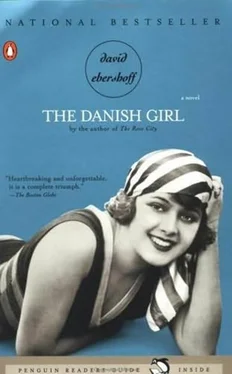And so there Einar would be-a little Danish man in the changing cabana of Paris’s finest ladies’ pool. At first he would be confused, his face blank in the hand mirror. He wouldn’t know where he was, couldn’t recognize the reverse stripes of the inside of the cabana’s canvas. Didn’t recognize the slip and splash of the ladies swimming laps. The only clothing on the hanger was a simple brown dress with a belt. Black shoes with wedgy heels. A purse with a few coins and a lipstick. A chiffon scarf patterned with pears. He was a man, he would suddenly think, and yet he had no way back to the apartment unless he put on all these clothes. Then he’d see the double string of Danish amber beads; his grandmother had worn them her whole life, even when farming the sphagnum fields, the beads around her throat clickety-clacketing against her sternum as she stooped to fill in the hole of a red fox. She had given them to Greta, who hated amber, who gave them to Einar; and Einar-he recalled-gave them to a little girl named Lili.
It came to him like that: in pieces, slowly, triggered by the amber beads or the swat of the attendant’s hand against the canvas door as she inquired once again whether mademoiselle needed assistance. He would put on the brown dress and the wedgy shoes as best he could. He would burn with shame as he clasped the belt, although now it would seem to him that he knew nothing about the tricky snaps and clasps of a woman’s dress. His purse held only a few francs; more weren’t coming for another three days, he knew. But Einar would decide against walking and take a cab back to the apartment because the discomfort of the brown dress was too much to bear on the streets of Paris. The scarf hung over the back of the chair, nearly fluttering on its own, and Einar couldn’t bear to tie it over his head and around his throat. It looked as if it might strangle him, the gauzy chiffon with the yellow pears. It belonged to someone else.
And so Einar would set out from the ladies’ pool in Lili’s clothes, with the rubber bathing cap still on his head, dropping a franc into the attendant’s ever-extended hand, gliding like the little duck on the pool’s surface, above the whispery gossip of the French ladies who would linger at the pool until it was time to return home and help their Polish maids prepare lunch for their pinafored children, while Einar, sloppy and red-eyed in Lili’s clothes, would return to Greta, who, in the course of the morning, had set the props and sketched the study for another painting of Lili.

One day in early May, Einar was sitting in the place des Vosges, on a bench beneath a hedge of trees. The wind kept lifting the fountain’s trickle, throwing it at his feet and staining the sand-colored gravel around him. In the morning Lili had gone for a swim. In the afternoon, Einar had returned to Madame Jasmin-Carton’s and witnessed through the little black glass a man and woman make love on the floor. It had cost him three times the usual entry fee; Madame Jasmin-Carton had been advertising the spectacle for a month on note cards tacked above the peep windows. The note cards, with the information of the public liaison neatly printed out, reminded Einar of the notes Lili and Greta had used to communicate with each other during the early days in Denmark: as if there were something about the crisp, echoey air of Copenhagen that couldn’t support the secret words they needed to say.
The boy was tall and stringy, not much more than an adolescent with his bluish-white skin and sleepy blue eyes and ribs that could be counted one, two, three. He quickly peeled himself out of his cheap tweed suit, and then helped the woman, who was older, out of her dress. Not counting himself, Einar had never before seen a man sexually aroused, the way it pointed up like a spear in the first inches of its trajectory. The boy’s was red-tipped and drippy and angry. The woman took it in her easily, and then, at just that moment, seemed grateful. They thrashed around on the floor of the little dark half-circle room, while pressed to every window was the face of a man old enough to be the boy’s grandfather. Quickly he finished up, his seed flying up in a heavy arc into the woman’s puckered face. He stood and bowed. He left the room, his tweed suit a bundle under his arm. Only then, when Einar looked down into his own lap, did he discover the salty stain, as if a teacup of seawater had overturned. Then he knew, although he supposed he had always known: he wanted the boy to do that to Lili. To kiss her just before the boy’s chest flushed red and his mouth twisted with pleasure.
After that, Einar found himself on the bench in the place des Vosges. He opened his coat to allow his lap, which he had rinsed out in Madame’s hand basin, to dry. Children were splashing each other in the fountain and pushing hoops across the gravel paths, and one girl was flying a paper kite shaped like a bat. Italian governesses were talking loudly over their prams parked in a circle. Einar turned away from them, embarrassed by his stain. The sun had been warm at the pool that morning, but now it kept slipping behind streamers of clouds, the park suddenly turning gray, the children, it seemed, mere cutouts of themselves. Einar’s lap wouldn’t dry. The wet wool reminded him of the dogs on the farm in Bluetooth, how they’d come home from a day hunting for frogs. They’d be crusty and dank, their fur hard, and they’d never really lose that wet smell.
The little girl with the kite let out a scream. The string had slipped out of her hand and now the kite was tumbling from the sky. She was following it with her finger as it fell. Then she began to run, the bow in her hair flopping against her ears. Her governess yelled for her to stop. The governess looked angry, her Italian face red and stormy. She told the little girl, Martine, to wait by the pram. The kite was hurtling toward the earth, its black paper fluttering in its frame. Then it crashed near Einar’s foot.
The governess snatched the crumpled kite with a pretty hand and a hiss. Then she took Martine ’s wrist and led her back to the pram, pulling her close to her side. The other governesses were standing under the hedge of trees, their prams huddled together at the bumper. When Martine and her governess joined them, they all looked over their shoulders in suspicion. Then the pack wheeled away, the squeak of their wheels a cry.
This was when Einar knew something had to change. Einar had become a man governesses feared in a park. Einar was a man with suspicious stains on his clothes.
It was May 1929, and he would give himself exactly one year. The park was dim, the sun hidden by clouds. The hedge of trees, with their fresh leaves shaking, looked cold. Again, a wind lifted the trickling water from the fountain and sprayed it onto the gravel. If in exactly one year Lili and Einar weren’t sorted out, he would come to the park and kill himself.
It made him straighten his back. He could no longer bear the chaos in his life. Greta owned a silver-plated pistol from her California days. She’d grown up with it tucked in her stocking. He would return to the park with it and, under the black May night, he would press it to his temple.
Einar heard footsteps running toward him, and he looked up from his lap. It was Martine in her yellow pinafore. She looked frightened but enthusiastic. She stopped running and inched closer. Her soft hand reached out. Between Einar and her lay the kite’s tail, a row of rag-bows on a string. Martine wanted it, and from the little smile pushing through her frown, Einar could tell she wanted to be friendly with him. She grabbed the tail. Then she laughed, her face like gold. When she curtsied and said “Merci,” everything Einar knew about himself pressed together as one: the cottongrass apron strings around his waist; his head held in Greta’s young hands; Lili in the sennep -yellow shoes in the Widow House; Lili this morning swimming laps in the river pool. Einar and Lili were one, but it was time to split them in two. He had one year.
Читать дальше













